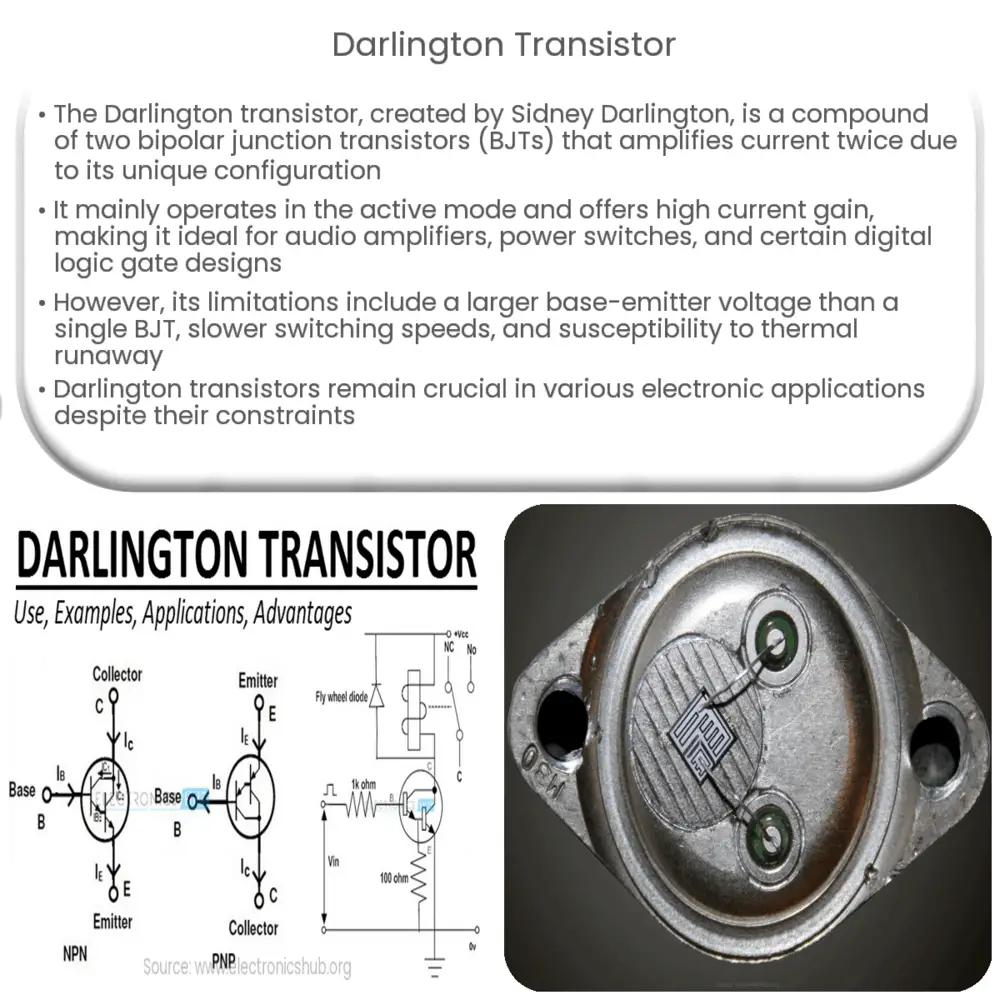Explore the world of Darlington Transistors – their operation, unique characteristics, applications, benefits, and limitations in our comprehensive guide.

Darlington Transistor: An In-Depth Look
A Darlington transistor, named after its inventor Sidney Darlington, is an intriguing and unique electronic component. It’s essentially a compound structure of two bipolar junction transistors (BJTs) connected in such a way that the current amplified by the first transistor is amplified again by the second one.
Let’s dive deeper into the essence of this type of transistor, its operational principles, and its practical applications in various electronic devices.
The Essence of a Darlington Transistor
The Darlington transistor, also known as Darlington pair, is unique due to its configuration. Two transistors are connected in a way that the emitter of the first transistor is directly connected to the base of the second, while the collector of both transistors is connected together. This configuration creates a high current gain that is equal to the product of the gains of the two transistors.
- The collector current of the first transistor becomes the base current of the second transistor.
- Overall, the input current gets amplified twice, resulting in a high total current gain.
Operation Principles of Darlington Transistor
The operational principles of Darlington transistors are based on the properties of BJTs. A BJT is a three-layer, two pn-junction device, and depending on the biasing conditions, it can operate in three different modes – active, cut-off, and saturation.
- In the active mode, the transistor functions as an amplifier.
- In the cut-off mode, the transistor is in the non-conducting state.
- In the saturation mode, the transistor is in the fully conducting state.
In a Darlington pair, both transistors work together to operate primarily in the active mode, amplifying the input signal. However, due to the specific configuration, the Darlington pair has a higher base-emitter voltage than a single BJT.
Applications of Darlington Transistors
Darlington transistors find their use in various applications where a high current gain is required. They are commonly used in audio amplifiers, power switches, and relay drivers due to their high current and power capabilities. They also find their use in the design of Base Transistor Logic (BTL) circuits, a type of digital logic gate design that uses bipolar junction transistors.
Characteristics of Darlington Transistors
Due to their unique construction, Darlington transistors exhibit certain distinct characteristics:
- High current gain: As mentioned before, the primary advantage of a Darlington pair is its extremely high current gain, which is the product of the gains of the two transistors.
- High input impedance: This is another significant advantage. High input impedance means the Darlington pair will not load down the preceding stage of a circuit.
- High Collector-Emitter saturation voltage: The saturation voltage of a Darlington pair is higher than that of a single transistor due to the extra VBE drop of the second transistor.
Limitations of Darlington Transistors
While Darlington transistors have many advantages, they also have some limitations:
- The base-emitter voltage of a Darlington pair is larger than a single BJT, which can be a disadvantage in low-voltage applications.
- The switching speeds are slower because the first transistor has to come out of saturation before the second one can.
- They are more prone to thermal runaway, a condition where the transistor junction temperature increases, leading to an increase in collector current, which further increases the temperature.
Conclusion
In conclusion, Darlington transistors are a fascinating component in the field of electronics. Their unique design and high current gain make them an invaluable tool in many applications, particularly those requiring amplification and power switching. However, like all electronic components, they have their limitations, which need to be considered during circuit design. Despite these, the Darlington transistor continues to hold its place as a key component in many electronic devices and systems, testament to the ingenious design by Sidney Darlington.

